1998 GMC SIERRA tires
[x] Cancel search: tiresPage 347 of 452
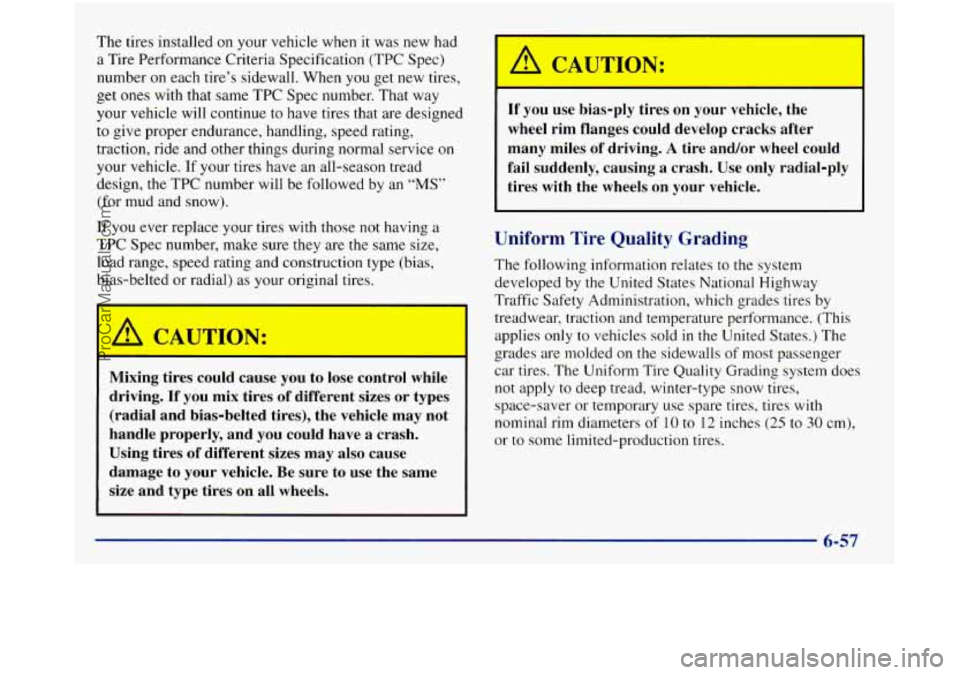
The tires installed on your vehicle when it was new had
a Tire Performance Criteria Specification (TPC Spec)
number on each tire’s sidewall. When
you get new tires,
get ones with that same TPC Spec number. That way
your vehicle will continue to have tires that are designed
to give proper endurance, handling, speed rating,
traction, ride and other things during normal service
on
your vehicle. If your tires have an all-season tread
design, the
TPC number will be followed by an “MS”
(for mud and snow).
If you ever replace your tires with those not having a
TPC Spec number, make sure they are the same size,
load range, speed rating and construction type (bias,
bias-belted or radial) as your original tires.
Mixing tires could cause you to lose control while
driving.
If you mix tires of different sizes or types
(radial and bias-belted tires), the vehicle may not
handle properly, and you could have a crash.
Using tires of different sizes may also cause
damage to your vehicle. Be sure to use the same
size and type tires on all wheels.
I A CAUTION:
If you use biasuply tires on your vehicle, the
wheel rim flanges could develop cracks after
many miles of driving.
A tire and/or wheel could
fail suddenly, causing a crash. Use only radial-ply
tires with the wheels on your vehicle.
Uniform Tire Quality Grading
The following information relates to the system
developed by the United States National Highway
Traffic Safety Administration, which grades tires by
I treadwear, traction and temperature performance. (This
applies only to vehicles sold
in the United States.) The
grades are molded on the sidewalls of most passenger
car tires. The Uniform Tire Quality Grading system does
not apply to deep tread, winter-type snow tires,
space-saver or temporary use spare tires, tires
with
nominal rim diameters of 10 to I2 inches (25 to 30 cm),
or to some limited-production tires.
6-57
ProCarManuals.com
Page 348 of 452
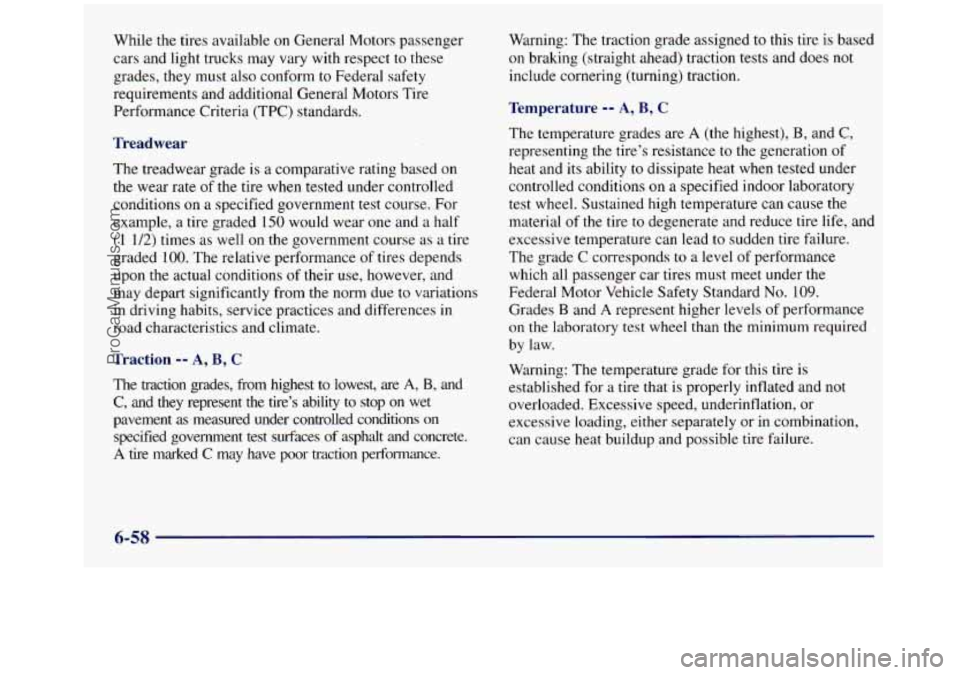
While the tires available on General Motors passenger
cars and light trucks may vary with respect to these
grades, they must also conform to Federal safety
requirements and additional General Motors Tire
Performance Criteria (TPC) standards.
Treadwear
The treadwear grade is a comparative rating based on
the wear rate of the tire when tested under controlled
conditions on a specified government test course. For
example, a tire graded 150 would wear one and a half
(1 1/2) times as well on the government course as a tire
graded
100. The relative performance of tires depends
upon the actual conditions of their use, however, and
may depart significantly from the norm due to variations
in driving habits, service practices and differences in
road characteristics and climate.
Traction -- A, B, C
The traction grades, from highest to lowest, are A, B, and
C, and they represent the tire’s ability to stop
on wet
pavement
as measured under controlled conditions on
specified government test surfaces of asphalt and concrete.
A tire marked C may have poor traction performance. Warning:
The traction grade assigned to this tire is based
on braking (straight ahead) traction tests and does not
include cornering (turning) traction.
Temperature -- A, B, C
The temperature grades are A (the highest), B, and C,
representing the tire’s resistance to the generation of
heat and its ability
to dissipate heat when tested under
controlled conditions
on a specified indoor laboratory
test wheel. Sustained high temperature can cause the
material of
the tire to degenerate and reduce tire life, and
excessive temperature can lead to sudden tire failure.
The grade
C corresponds to a level of performance
which
all passenger car tires must meet under the
Federal Motor Vehicle Safety Standard
No. 109.
Grades B and A represent higher levels of performance
on the laboratory test wheel than the minimum required
by law.
Warning: The temperature grade for this tire is
established for a tire that is properly inflated and
not
overloaded. Excessive speed, underinflation, or
excessive loading, either separately or in combination,
can cause heat buildup and possible tire failure.
6-58
ProCarManuals.com
Page 349 of 452
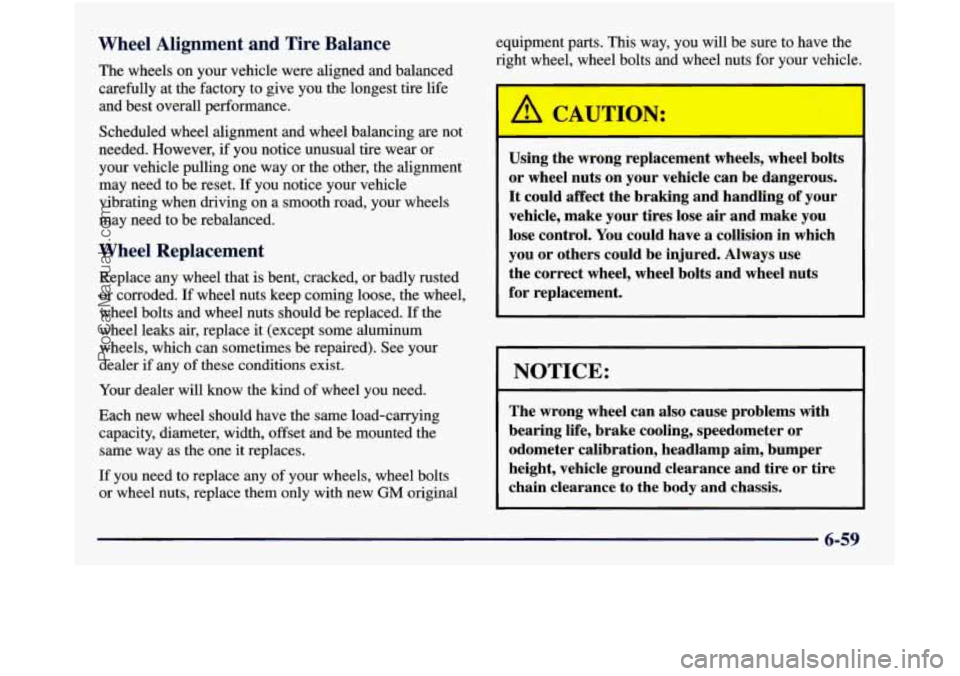
Wheel Alignment and Tire Balance
The wheels on your vehicle were aligned and balanced
carefully at the factory to give you the longest tire life
and best overall performance.
Scheduled wheel alignment and wheel balancing are not
needed. However,
if you notice unusual tire wear or
your vehicle pulling one way or the other, the alignment
may need to be reset.
If you notice your vehicle
vibrating when driving on a smooth road, your wheels
may need to be rebalanced.
Wheel Replacement
Replace any wheel that is bent, cracked, or badly rusted
or corroded. If wheel nuts keep corning loose, the wheel,
wheel bolts and wheel nuts should be replaced. If the
wheel leaks
air, replace it (except some aluminum
wheels, which can sometimes be repaired). See your
dealer if any
of these conditions exist.
Your dealer will know the kind of wheel you need.
Each new wheel should have the same load-carrying
capacity, diameter, width, offset and be mounted the
same way as the one it replaces.
If you need to replace any of your wheels, wheel bolts
or wheel nuts, replace them only with new
GM original equipment
parts. This way, you will be sure to have the
right wheel, wheel bolts and wheel nuts for your vehicle.
~ Using the wrong replacement wheels, wheel bolts
or wheel nuts on your vehicle can be dangerous.
It could affect the braking and handling of your
vehicle, make your tires lose air and make you
lose control. You could have a collision in which
you or others could be injured. Always use
the correct wheel, wheel bolts and wheel nuts
for replacement.
~
NOTICE:
The wrong wheel can also cause problems with
bearing life, brake cooling, speedometer or
odometer calibration, headlamp aim, 'bumper
height, vehicle ground clearance and tire or tire
chain clearance to the body and chassis.
6-59
ProCarManuals.com
Page 350 of 452
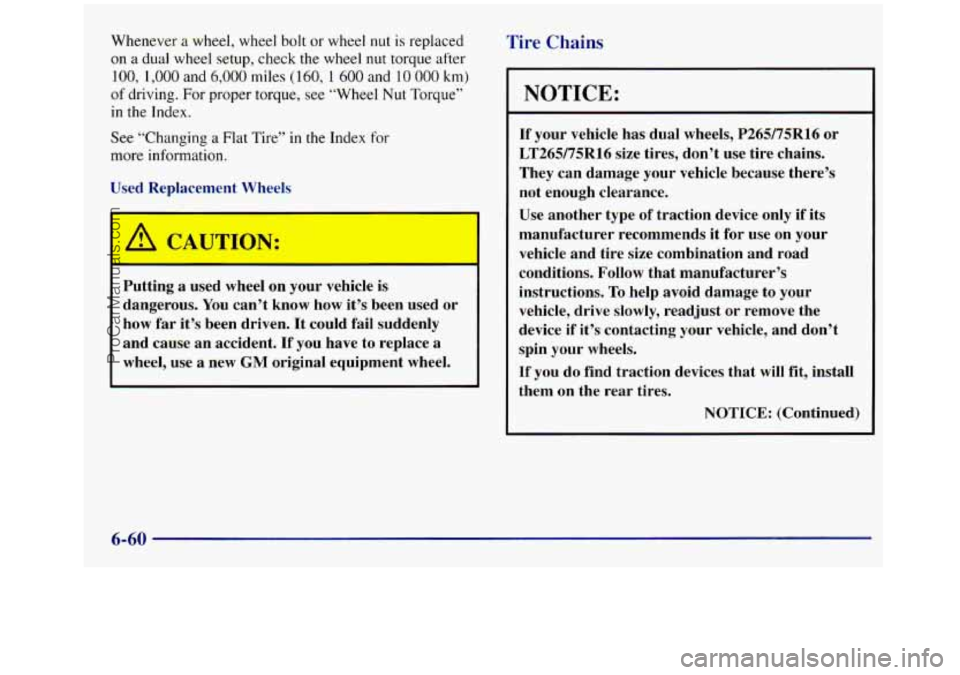
Whenever a wheel, wheel bolt or wheel nut is replaced
on
a dual wheel setup, check the wheel nut torque after
100, 1,000 and 6,000 miles ( 160, 1 600 and 10 000 km)
of driving. For proper torque, see “Wheel Nut Torque’’
in the Index.
See “Changing
a Flat Tire” in the Index for
more information.
Used Replacement Wheels
/!1 CAUTION:
Putting a used wheel on your vehicle is
dangerous.
You can’t know how it’s been used or
how
far it’s been driven. It could fail suddenly
and cause an accident. If
you have to replace a
wheel, use a new GM original equipment wheel.
Tire Chains
NOTICE:
If your vehicle has dual wheels, P265/75R16 or
LT265/75R16 size tires, don’t use tire chains.
They can damage your vehicle because there’s
not enough clearance.
Use another type of traction device only
if its
manufacturer recommends it for
use on your
vehicle and tire size combination and road
conditions.
Follow that manufacturer’s
instructions. To help avoid damage to your
vehicle, drive slowly, readjust or remove the
device
if it’s contacting your vehicle, and don’t
spin your wheels.
If you do find traction devices that will fit, install
them on the rear tires.
NOTICE: (Continued)
6-60
ProCarManuals.com
Page 351 of 452
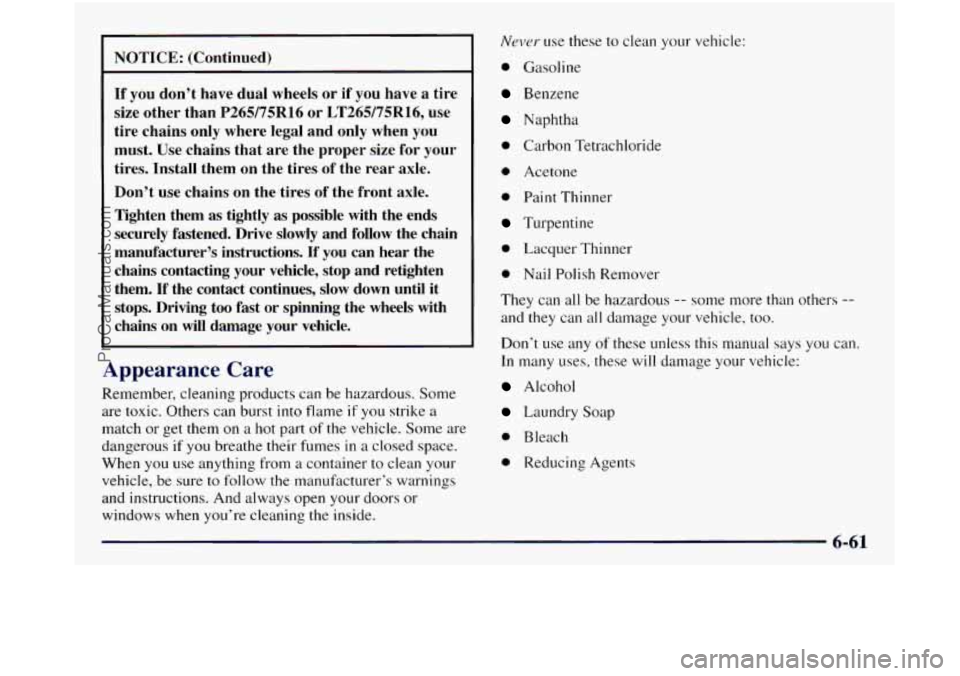
NOTICE: (Continued) -
If you don’t have dual wheels or if you have a tire
size other than
P265/75R16 or LT265/75R16, use
tire chains only where legal and only when you
must. Use chains that are the proper size for your
tires. Install them on the tires of the rear axle.
Don’t use chains on the tires of the front axle.
Tighten them
as tightly as possible with the ends
securely fastened. Drive slowly and follow the chain
manufacturer’s instructions. If you can hear the
chains contacting your vehicle, stop and retighten
them.
If the contact continues, slow down until it
stops. Driving too fast or spinning the wheels with
chains on will damage your vehicle.
Appearance Care
Remember, cleaning products can be hazardous. Some
are toxic. Others can burst into flame
if you strike a
match or get them on
a hot part of the vehicle. Some are
dangerous if
you breathe their fumes in a closed space.
When you use anything from
a container to clean your
vehicle, be sure
to follow the manufacturer’s warnings
and instructions. And always open your doors or
windows when you’re cleaning the inside.
NevcJr use these to clean your vehicle:
0 Gasoline
Benzene
Naphtha
0 Carbon Tetrachloride
0 Acetone
0 Paint Thinner
Turpentine
0 Lacquer Thinner
0 Nail Polish Remover
They can
all be hazardous -- some more th .an others --
and they can all damage your vehicle, too.
Don’t use any
of these unless this manual says you can.
In many uses, these will damage your vehicle:
Alcohol
Laundry Soap
0 Bleach
0 Reducing Agents
6-61
ProCarManuals.com
Page 357 of 452
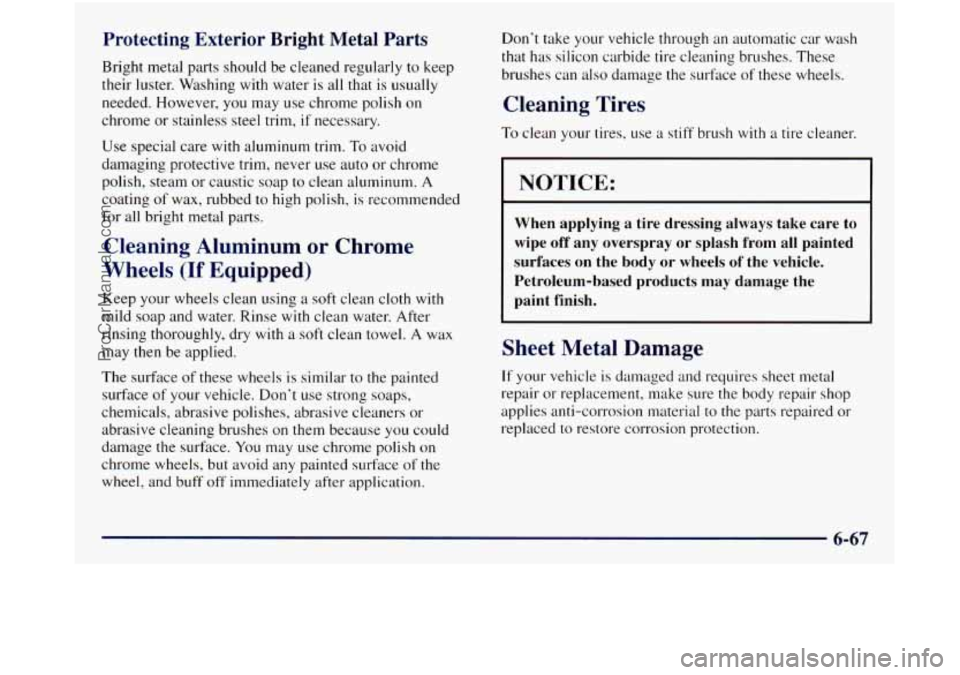
Protecting Exterior Bright Metal Parts
Bright metal parts should be cleaned regularly to keep
their luster. Washing with water is all that is usually
needed. However,
you may use chrome polish on
chrome or stainless steel trim, if necessary.
Use special care
with aluminum trim. To avoid
damaging protective trim, never use auto or chrome
polish, steam or caustic soap to clean aluminum.
A
coating of wax, rubbed to high polish, is recommended
for all bright metal parts.
Cleaning Aluminum or Chrome
Wheels (If Equipped)
Keep your wheels clean using a soft clean cloth with
mild soap and water. Rinse
with clean water. After
rinsing thoroughly, dry
with a soft clean towel. A wax
may then be applied.
The surface of these wheels is similar
to the painted
surface of your vehicle. Don’t use strong soaps,
chemicals, abrasive polishes, abrasive cleaners or abrasive cleaning brushes on them because you could
damage the surface.
You may use chrome polish on
chrome wheels, but avoid any painted surface of the
wheel, and buff off immediately after application. Don’t take your
vehicle through
an automatic car wash
that has silicon carbide tire cleaning brushes. These
brushes can also damage the surface of these wheels,
Cleaning Tires
To clean your tires, use a stiff brush with a tire cleaner.
I NOTICE:
When applying a tire dressing always take care to
wipe off any overspray or splash from all painted
surfaces on the body or wheels of‘the vehicle.
Petroleum-based products may damage the
paint finish.
Sheet Metal Damage
If your vehicle is damaged and requires sheet metal
repair or replacement, make sure the body repair shop
applies anti-corrosion material to the parts repaired or
replaced to restore corrosion protection.
6-67
ProCarManuals.com
Page 367 of 452
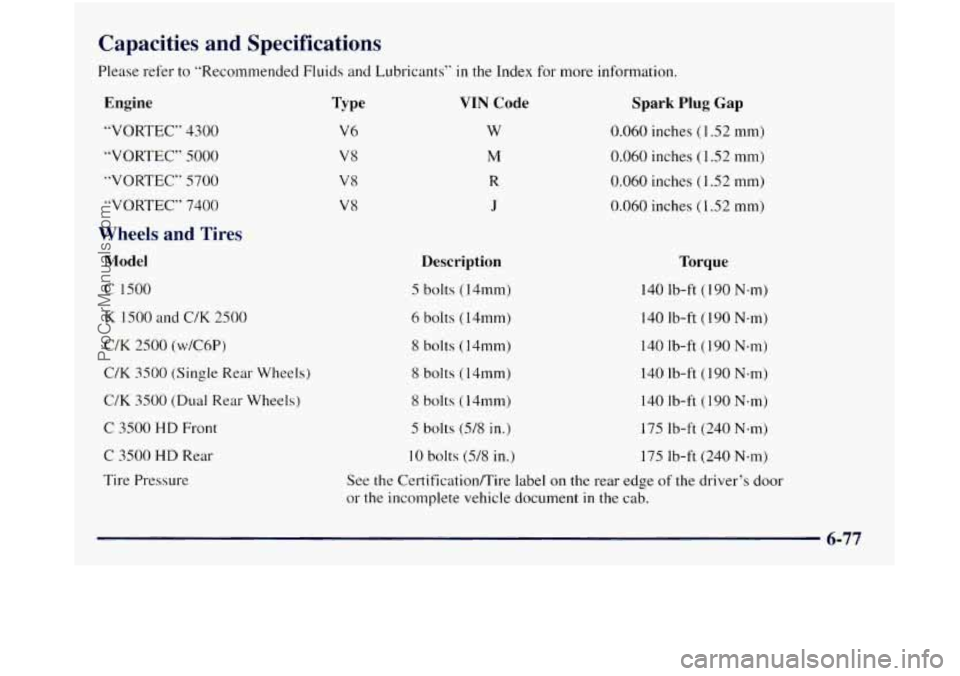
Capacities and Specifications
Please refer to ”Recommended Fluids and Lubricants” in the Index for more information.
Engine
“VORTEC” 4300
“VORTEC” 5000
”VORTEC“ 5700
“VORTEC“ 7400
Wheels and Tires
Model
C 1500
K 1500 and C/K 2500
C/K 2500 (w/C6P)
C/K
3500 (Single Rear Wheels)
C/K 3500 (Dual Rear Wheels)
C 3500 HD Front
C 3500 HD Rear
Tire Pressure
Type
V6
V8
V8
V8
VIN Code
w
M
R
J
Spark Plug Gap
0.060 inches ( 1.52 mm)
0.060 inches
(I .52 mm)
0.060 inches (1.52 mm)
0.060 inches (1 32 mm)
Description Torque
5 bolts (14mm) 140 lb-ft ( 190 Nem)
6 bolts
(14mm) 140 Ib-ft (190 N-m)
8 bolts (14mm) 140 lb-ft ( 190 N-m)
8 bolts
(14mm) 140 lb-ft ( 190 N-m)
8 bolts
(14mm) 140 lb-ft (190 Nsm)
5 bolts (5/8 in.) 175 Ib-ft (240 N-m)
10 bolts (5/8 in.)
175 lb-ft (240 Nem)
See the Certificationflire label on the rear edge of the driver’s door
or the incomplete vehicle document
in the cab.
6-77
ProCarManuals.com
Page 380 of 452
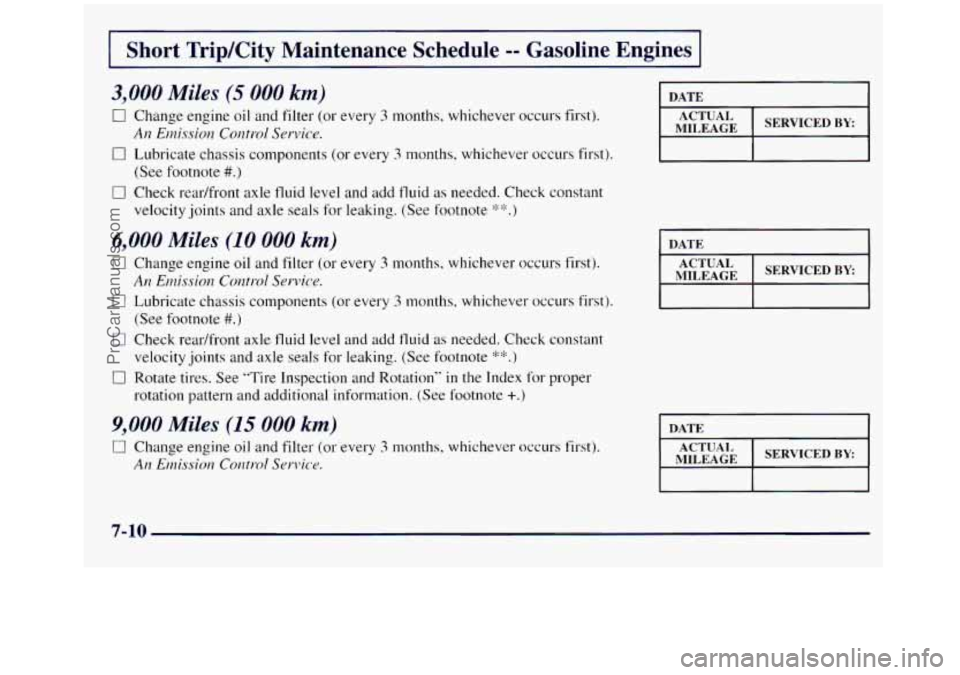
I Short TripKity Maintenance Schedule -- Gasoline Engines I
3,000 Miles (5 000 km)
Ci Change engine oil and filter (or every 3 months, whichever occurs first).
0 Lubricate chassis components (or every 3 months, whichever occurs first).
0 Check readfront axle fluid level and add fluid as needed. Check constant
An Etnission Comd Service.
(See footnote #.)
velocity joints and axle seals for leaking. (See footnote $'*.)
6,000 Miles (10 000 km)
Cl Change engine oil and filter (or every 3 months, whichever occurs first).
0 Lubricate chassis components (or every 3 months, whichever occurs first).
0 Check readfront axle fluid level and add fluid as needed. Check constant
0 Rotate tires. See "Tire Inspection and Rotation" in the Index for proper
An Emission Colztr-ol Service.
(See footnote #.)
velocity joints and axle seals for leaking. (See footnote **.)
rotation pattern and additional information. (See footnote +.)
9,000 Miles (15 000 km)
0 Change engine oil and filter (or every 3 months, whichever occurs first).
An EInisston Control Service.
I DATE I
I MILEAGE ACT I SERVICEDBY I
DATE
MILEAGE
DATE I
SERVICED BY
7-10
ProCarManuals.com